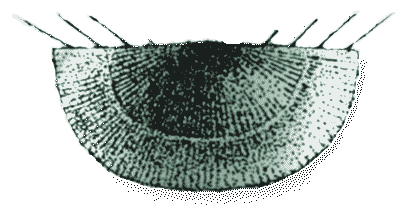Geology / Gallery

Chonetes striatellus (11)
Brachiopods ➚ are in the form of the two hinged shells. It is a group that was abundant in the Paleozoic and is important for stratigraphic purposes.
They also indicate the climate and depth of sea water in ancient times. As a sea inundated an area of land the successive layers of sediment contain fossils of brachipods that lived in water of progressively increasing depth.
Brachiopods are benthic (bottom of deep water) marine animals filtering food particles from the water siphoned in between the two protective valves.
This particular brachiopod is unusual in having the spines along the pedicle valve interarea. The shell has a plano-convex shape.
Chonetes striatellus lived in the Wenlock and Ludlow Series of the Silurian found in Shropshire, UK.
| Division | Name |
| Phylum | Brachiopoda |
| SubPhylum | Rhynchonelliformea |
| Class | Rhynchonellata |
| Order | Strophomenida |
| SubOrder | Chonetidina |
Fossil gallery
- Brittle Star : Lapworthia miltoni
- Trilobite : Dalmanites myops
- Crinoid : Eucalyptocrinites decorus
- Gastropod : Poleumita discorus
- Trilobite : Calymene blumenbachi
- Graptolite : Cyrtograptus murchisoni
- Sponge : Ischadites koenigi
- Conodont : Ozarkodina typica
- Brachiopod : Pentamerus oblongus
- Graptolite : Petalograptus minor
- Brachiopod : Chonetes striatellus
- Cystoid : Lepocrinetes quadrifasciatus
- Bivalve : Pteronitella retroflexa
- Graptolite : Monograptus lobiferus
- Gastropod : Platyceras haliotis
- Crinoid : Sagenocrinites expansus
- Brachiopod : Atrypa reticularis
